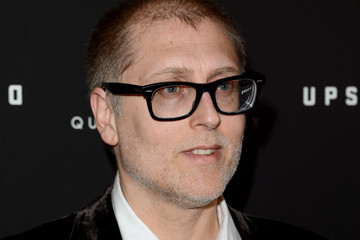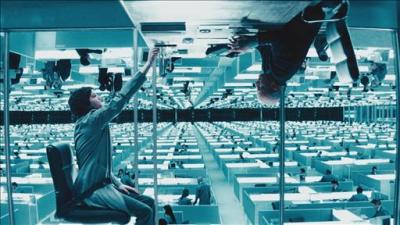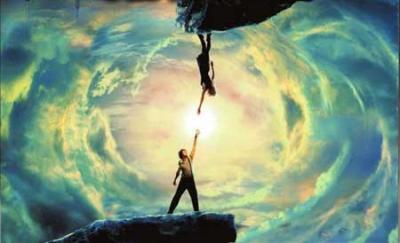By: debbie lynn elias
It takes both a visionary and visualist to create a film like UPSIDE DOWN. And that’s exactly who Juan Solanas is. A writer/director with a strong visual background in photography and art history, plus over 10 years work as a cinematographer, Solanas never ceases to amaze with his “outside the box” approach to life and filmmaking. With brilliant conceptualization from start to finish, a perfect blend of creativity, intellectual and emotional stimulation, and stunning, seemingly impossible, visuals, there is truly only one man who could breathe life into UPSIDE DOWN – Juan Solanas.
I sat down with Juan Solanas for this exclusive 1:1 interview during which his enthusiasm and passion for filmmaking and UPSIDE DOWN became an infectious delight and where I learned that sometimes you’ve got to look at life “upside down” to exist “right side up.”

Juan, this is a visual spectacular! I was mesmerized watching. From concept to fruition, where does something this creative and this beautiful arise? The physical concept alone immediately grabs me when you start your opening titles with physics and equations, dual gravitational pulls in a world. I‘m hooked! Then I see how you visually achieve it and my mind is reeling! This is beyond outside the box!
The truth is,when I was young I wanted to be an astrophysicist. But the movie is not scientific at all, but it‘s fun and playful for me to play God and make new rules in physics. I’m really a visual guy. And this is a true story – maybe at the end of my adolescence I fall in love with romantic painting and photographs and spent my time, looking, looking, looking, looking. That was my passion, before knowing that I want to be a director or whatever. But at that time I wanted to be an astrophysicist so it was parallel things. Then I started thinking of something that happened very often to me. I can be here with you now, and if a strong vision appears in my brain, I don‘t see you anymore and I visualize something else. I don’t have the control of that. I don’t drive because one day I [almost] killed myself because of that! I was driving and then I don’t know what happened. No more road. I was on my image and, whew! It was close! My way of thinking is really intricate with imagery building. My idea in movies, in my three movies, happened the same way. One day an image appears to me but like “in pose” to me. Like, here I am. And it’s not like I’m looking for an idea. The three times was the same way. I’m never looking for an idea. I cannot manage that. I cannot push a button. Ideas come to me. For UPSIDE DOWN, I was actually upset about finishing my first feature movie, so it was really hard to watch the movie. I was director and producer. I had a really hard time. At the end of the movie I was thinking, “I don’t know if I want to do it again.” So hard for me to as yet find a new idea. I thought “make a break and relax.” One morning I start to see an image. I don’t know where it’s coming from. I can’t explain. But, at the moment I saw this vision and suddenly I saw these two people, very near to what you see [on screen]. I visualized that; seeing a guy looking up and seeing a girl looking down, looking at each other. It’s actually myself as an audience of my brain who was this image and then understood the story. It’s a weird way, it’s not logical. So watching this image, I understood , of course, the potential, the fertility of the visual – and I am talking 7 years ago. I never saw an upside down world. As a visual guy, I get seduced, like, “Oh wow. That’s cool!” And at the same time understanding the love story but at the same time understanding the implication of that,the upside down device allowed me to speak about the world. I’m from Argentina, living upside down in Paris. I understand very quickly where it came from but in a very metaphoric way and thatfs the best way for me. When you have a deep process and you don’t know what happens and then something comes to you. There is a French writer from the 18th Century, romantic writer, and he speaks about creative processes saying that, in Spain, they used to put in a salt mine, a little piece of wood, put it on a rope, put it in the mine and recover this wood six months later. Then this wood is full of crystals. He said that for him, creativity is crystallization. I 100% agree. I can understand but I cannot go to this idea thinking, “I am Argentinian. I live in Paris.” After that, the idea came. You look at it, you take whatever you can take from that. And then you get in trouble! [laughing]
The way I write is like fishing in very deep water. You don’t know. You are very unbalanced, very painful because most of the time nothing happens. I can tell you often there is a white page and nothing happens. It’s not cool at all. You cannot program that. But here, you keep typing. I put on music to be in the mood and try to [create] and time to time, I catch a good fish. Like he arrives one day, unaware. He was with me and when he arrived, he’s there organically. So, it’s easy for me to then write his speech. It’s a very very deep process. Because Iam really my logic and visual cortex are linked together. When I write, I visualize what I am writing. So what the image came from? From that. After that, for me making a movie is just recreating exactly what I saw.

When you get imagery that is that beautiful and that powerful, how hard is it to find the words to put with those pictures?
Very hard. Very hard. I spend a lot of time doing research for images to show to people. I’m very bad with my hands so I cannot draw. I use, for example, in the computer, a software to make 3D things just to show people, “Look. That’s a double gravity office.” And then when I show them, I understood that they never understood what I was talking about! But then theyfre like, “Oh! I get that!” Everything I say, they don’t catch, but watching the image is then, “Okay!” That’s the way [for me]. Make a lot of documentation to show to people, having this model in 3D, whatever. Because I have a very precise idea, it wasnt hard at all to land on the concrete. I found Alex McDowell, production designer. He is the one who made a lot of Tim Burton movies, Minority Report. He did Watchman. He did Fight Club. Hefs a monster! A very rational monster.
And he did Cat in the Hat, too, so he‘s got an appreciation for vibrant color, the darkness of Tim Burton. And then you get Pierre Gill, your cinematographer.
Ah, yes! You know Gill? Cool! Pierre is a beautiful story. I had been for 10 years, a [Director of Photography] myself.

That right there, for me, knowing his visual ability, I knew going in, if UPSIDE DOWN came to fruition, if this concept worked, it would be a visual masterpiece. And it truly is. I don’t see how anybody could have made UPSIDE DOWN if they had not had cinematography experience because this is not only such a visual film, but a visually challenging film. You‘ve got a master-slave robotic camera system to perfect that “line of sight” aspect which is almost flawless. “Line of sight” is a factor that initially concerned me and I wondered, “How is he going to pull that off?” and not have Jim [Sturgess] looking over here and Kirsten [Dunst] looking over there.
Absolutely. One of my obsessions was “the line.” I created a department for the line problem. The second unit director, Mario Janelle, incredible guy – director and DP – is a crazy inventor. He invented a motion control camera. He invents things!
He has a little bit of the character of Adam in him.
Yes! Of course! I said, “Mario, you are the head of the line problem department.” He figured out, using two-hand motion control. It’s like a hunter. On one side you have a guy who points the eyes of the character and then on the other set you have a laser beam lighting very transparent things. You point at a guy at work, and the same movement is calculated by the other hand to redo on the other side at the same place. So actually, Kirsten Dunst was here [motioning] and watching a red dot knowing exactly the place [where Jim Sturgess would be] on the other world. For me that was very important. I believe, really, that acting is reacting. You don’t react very well to a tennis ball. You don’t give an actor to be a chance to be really good. Hey, do the minimum they can do and that’s it. So for me, the obsession was to shoot this organically, meaning I want the actors to play together at the same moment, not like motion control one take and then a week later the other part. Wrong!!! I wanted to improv and I love to give the actors the freedom to find their own words. Yes, the lines are the lines, but you can change them to be a sweeter line.

With the emotion in this film, that is such an important aspect of it.
Oh yeah! The first week I had the idea, I started writing the script and at the same time in parallel finding a way to shoot this. I was alone, there was no producer, nothing. I was just writing for me thinking “that’s crazy. Never gonna happen.” But, I don’t care, I write my story. And finding a way to shoot it. Then I have the idea of master-slave. And it’s because of the acting! If I don’t find the [way] to do it, I don‘t want to make a cold, post-production effects movie. I don’t want that. If I don’t have the idea, I don’t do the movie. For me, it was a good thing. Being organic and having emotion, emotion, emotion!

It works beautifully. This is a masterful film. Having spent seven years of your life bringing this to life, as you look back on it, what did you learn about yourself over this seven year journey?
It was a fight. I learned that there is only one thing – don‘t give up and work, work, work. The movie is about love, but making that movie is about love. If you don’t care, then just push a button and die now. If you care, and when you are a director and a brighter director, the movie is like your child. I am a father, so it’s not “really” like my loving child, but that’s what it is. You do whatever you can do at your maximum. The last three years working Monday to Sunday, minimum 12 hours a day, because whatever you can do to improve, you do! It’s like I want to be sure I give the maximum. Then if I give the maximum, it is what it is. You cannot do more than your maximum, but at least you do your maximum. It’s a fight. Every movie is a fight, a beautiful fight, because reality never fits. For example. This is the last shot of the movie, on a beach, the sun, the sun. Oh, it’s raining! But, but! We can’t go, “But God!” and then “Can’t we shoot tomorrow?” No. And then you need to figure out what to do. And that’s about making a movie! That‘s why you burn your brain to find solutions, but good solutions, not technical solution. A solution that means something. And sometimes, accidents push you to go farther and to find better things.
#











